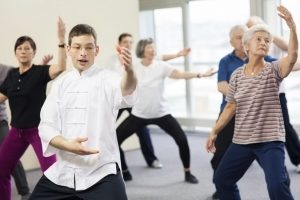Relieve Chronic Low Back Pain with Tai Chi
By John M. de Castro, Ph.D.
“Tai Chi has demonstrated usefulness in the prevention and treatment of certain problems such as back pain. Importantly, Tai Chi is non-invasive, relatively inexpensive, and gentle on the spine, so many people with back pain are starting to try it as an adjunct to (or sometimes instead of) traditional medical approaches to manage back pain. Furthermore, Tai Chi does not require any expensive equipment and can be practiced anywhere.” – Robert Humphreys
Low Back Pain is the leading cause of disability worldwide and affects between 6% to 15% of the population. It is estimated, however, that 80% of the population will experience back pain sometime during their lives. There are varied treatments for low back pain including chiropractic care, acupuncture, biofeedback, physical therapy, cognitive behavioral therapy, massage, surgery, opiate pain killing drugs, steroid injections, and muscle relaxant drugs. These therapies are sometimes effective particularly for acute back pain. But, for chronic conditions the treatments are less effective and often require continuing treatment for years and opiate pain killers are dangerous and can lead to abuse, addiction, and fatal overdoses.
Obviously, there is a need for safe and effective treatments for low back pain that are low cost and don’t have troublesome side effects. Mindfulness practices are effective in treating pain and have been shown to be safe and effective in the management of low back pain. Tai Chi is a mindfulness practice that is safe and gentle and has been shown to improve spinal health and reduce pain. So, it would seem reasonable to examine the ability of Tai Chi practice to treat chronic low back pain.
In today’s Research News article “Chen-Style Tai Chi for Individuals (Aged 50 Years Old or Above) with Chronic Non-Specific Low Back Pain: A Randomized Controlled Trial.” (See summary below or view the full text of the study at: https://www.ncbi.nlm.nih.gov/pmc/articles/PMC6388249/), Liu and colleagues recruited older adults (aged 50 and over) who were diagnosed with chronic low back pain and randomly assigned them to receive Chen Style Tai Chi training, deep core stabilization exercise, or a no-treatment control condition. Tai Chi and core stabilization exercise practice occurred for 60 minutes three times per week for 12 weeks. They were measured before and after training for lower back pain intensity and for knee and ankle joint position matching ability (proprioception).
They found that in comparison to baseline and the control group both Tai Chi training and core stabilization exercise produced a significant decrease in lower back pain, with Tai Chi training producing the greatest relief of the pain. There were, however, no significant effects of training on knee and ankle joint proprioception.
The study is significant in that it demonstrates that Tai Chi practice is a safe and effective treatment to relieve chronic low back pain in older adults. This pain is a major problem decreasing their ability to fully engage in daily and work activities. So the relief of the pain by Tai Chi practice should contribute to a marked increase in their quality of life.
Tai Chi is not strenuous, involving slow gentle movements, and is safe, having no appreciable side effects, it is appropriate for all ages including the elderly and for individuals with illnesses that limit their activities or range of motion. It can also be practiced without professional supervision and in groups making it inexpensive to deliver and fun to engage in. This makes Tai Chi practice an excellent means to treat with chronic low back pain.
So, relieve chronic low back pain with Tai Chi.
“Some solid research shows that tai chi can benefit people with osteoarthritis, rheumatoid arthritis, fibromyalgia, tension headache, and other ongoing, painful conditions.” – Harvard Health
CMCS – Center for Mindfulness and Contemplative Studies
This and other Contemplative Studies posts are also available on Google+ https://plus.google.com/106784388191201299496/posts and on Twitter @MindfulResearch
Study Summary
Liu, J., Yeung, A., Xiao, T., Tian, X., Kong, Z., Zou, L., & Wang, X. (2019). Chen-Style Tai Chi for Individuals (Aged 50 Years Old or Above) with Chronic Non-Specific Low Back Pain: A Randomized Controlled Trial. International journal of environmental research and public health, 16(3), 517. doi:10.3390/ijerph16030517
Abstract
Tai Chi (TC) can be considered safe and effective intervention to improve pain and pain-related functional disability. However, it is unclear that whether aging individuals with Chronic Non-Specific Low Back Pain (CNS-LBP) can achieve positive results. This study, therefore, attempted to explore the effects of TC on pain and functional disability in CNS-LBP patients aged 50 years old or above. Forty-three individuals (aged 50 years old or above) with CNS-LBP were randomly assigned into three groups: Chen-Style TC group (n = 15), Core Stabilization training (CST) group (n = 15), and control group (n = 13). Participants in the TC group participated in Chen-style TC training program (three 60-min sessions per week for 12 weeks), individuals in CST group received 12-week Core Stabilization exercise on the Swiss ball, whereas individuals in the control group maintained their unaltered lifestyle. Pain intensity as primary outcome was measured using the Visual Analogue Scale (VAS), A BiodexSystem 3 isokinetic dynamometer was used to measure knee and ankle joint position sense (JPS) as secondary outcomes at baseline and after the 12-week intervention. TC and CST have significant effects in VAS for CNS-LBP patients (p< 0.01, TC group OR CST group versus control group in mean of the post-minus-pre assessment). However, the feature of joint position sense (JPS) of ankle inversion, ankle eversion and knee flexion did not occur, it showed no significant effects with TC and CST. TC was found to reduce pain, but not improve lower limb proprioception in patients with CNS-LBP. Future research with larger sample sizes will be needed to achieve more definitive findings on the effects of TC on both pain and lower limb proprioception in this population.
https://www.ncbi.nlm.nih.gov/pmc/articles/PMC6388249/
